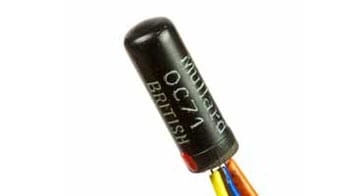Home » Component data » Transistor data » this page
OC71 Transistor Data
Key transistor data for the OC71 PNP audio germanium transistor including key electrical parameters, pinout, package type and many other key transistor datasheet details.
The OC71 was a general purpose audio low power amplifier housed in a black painted glass encapsulation to provide rugged protection of the device.

Key details and performance parameters for the OC71 transistor.
| nnn transistor datasheet parameters & data |
|
|---|---|
| Parameters | Details |
| Transistor type | PNP germanium audio transistor |
| Package type | |
| VCBO max (V) | -20 |
| VCEO max (V) | -20 |
| VEBOmax (V) | 10 |
| IC max (mA) | 10 |
| TJ Max °C | 80 |
| PTOT mW | 125 |
| fT min (MHz) | 0.3 |
| COB | 30 |
| hfe | 30 min |
| IC for hfe | 5mA |
| Similar / equivalents | |
Outline:
Pinout:
Explanation of transistor parameters
| Parameter | Explanation |
|---|---|
| VCBO Max | Maximum collector-base voltage with emitter open circuit . |
| VCEO Max | Maximum collector-emitter voltage with base open circuit. |
| VEBO Max | Maximum emitter-base voltage with collector open circuit. |
| VCEsat (included where applicable) | The voltage drop across the collector-emitter when the transistor is fully saturated (acting as a closed switch). |
| IC Max | Maximum collector current. |
| Parameter | Explanation |
|---|---|
| TJ | Maximum junction temperature. |
| PTOT Max | Maximum device dissipation normally in free air at 25°C unless other conditions indicated. |
| fT Min | Minimum cutoff frequency at which the current gain in a common emitter circuit falls to unity. |
| COB Max | Maximum collector capacitane, normally measured with emitter open circuit. |
| hFE | DC current gain for HFE at IC. [Note hfe is the small signal gain and although this may be slightly different, the transistor current gain will vary considerably from ne transistor to the next of the same type.] |
| PTOT Max | Maximum device dissipation normally in free air at 25°C unless other conditions indicated. |
These are the main transistor parameters that have been included in our list. There are others, but these help quantify the main elements of the performance of the transistor.
Please note, that the data given is the best estimate we can give within a tabulated summary of this nature. Parameters also vary between manufacturers. Electronics Notes cannot accept any responsibility for errors, inaccuracies, etc, although we do endevaour to ensure the data is as accurate as possible.
Notes and supplementary information
• YouTube video
Video: The OC71 Transistor: Myths, Legends & Performance
• Notable features
The Mullard OC71 is one of the most historically significant transistors, as it was one of the first commercially mass-produced germanium junction transistors in the mid-1950s, making it a foundation stone of the early transistor radio era.
Construction Type: It is a Germanium (Ge) PNP small-signal transistor, typically manufactured using the alloy junction process, which was a key method for mass-producing reliable transistors at the time.
Classic Encapsulation: The device is recognizable by its classic black-painted glass encapsulation (SO-2 or TO−1 outline), often with an aluminium sleeve for the OC72, but the OC71 itself usually came in the SO−2 style, sometimes referred to as 'black glass'.
General Purpose Audio: It was explicitly designated as a general-purpose audio frequency transistor, typically used for voltage amplification in audio frequency stages of radios and early transistor equipment.
Light Sensitivity: Due to the glass encapsulation, the germanium junction is naturally light-sensitive. The black paint (often called 'dope') was applied to shield the device from ambient light, which could otherwise alter the operating characteristics (gain/leakage). The non-painted and specially selected version was sold separately as the OCP71 phototransistor.
Temperature Concerns: Like all germanium transistors, it has a relatively low maximum junction temperature (typically +80°C to +100°C) and is prone to thermal runaway due to its inherent high temperature-dependent leakage current (ICBO), requiring careful circuit design and management of thermal aspects.
• Typical applications summary
| Application Category | Typical Use Case | Device Feature Utilised |
|---|---|---|
| Vintage Radio Circuits | AF (Audio Frequency) Voltage Amplification Stages | General purpose low-power current gain (hFE) for AF signal amplification. |
| Early Portable Electronics | AF pre-amplifiers and small-signal switching | PNP polarity and Germanium's low forward voltage drop, suitable for low-voltage battery operation. |
| Guitar Effects Pedals (Modern) | Vintage-style Fuzz, Treble Boost (e.g., Rangemaster clones) and Overdrive circuits | Germanium's characteristic "vintage" tone and unique distortion/clipping response, highly sought after by audiophiles and musicians. |
• Timeline
The OC71 was one of the first transistors available for both industrial and home experimentation. Its number is engrained in the minds of many electronics and radio enthusiasts of the day.
The device was a general purpose audio transistor which was launched in 1954 by the Phillips company which also owned the British company Mullard.
The OC71 was manufactured in large quantities and devices bearing the Philips and the Mullard names can still be seen in many component boxes and in many radios, etc.
In fact the OC71 was a replacement for an earlier transistor, the OC11 which had been developed as a general purpose audio transistor.
• OCP71 phototransistor& OC71
The OC71 was housed in a glass encapsulation. This was painted black to prevent it being affected by light. A phototransistor - the OCP71 in some respects an OC71 without the black paint.
But there was more to it than this Transistor manufacturing of the time gave significant variability of transistor parameters, especially between batches.
Accordingly the different types were often as a result of a selection process. The OCP71 was selected for better light detection, and it was also packaged differently.
The basic OC71 transistor device itself was dipped in a light blue putty material and then covered in a paste that reduced light transmission and conducted heat away. Finally the device was encapsulated within its glass package which was painted black and marked. The reason for this light protection was to ensure the performance remained constant whatever the light levels.
The OCP71 was packaged differently using a clear silicon grease that gave much better light conduction as well as providing heat transfer away from the semiconductor device itself.
As the OCP71 was sold at a higher price than the OC71, many people removed the black paint.
There were stories that the manufacturers started to introduced OC71s with a black silicone grease within the glass encapsulation.
This reason was actually because the black paint on the OC71 would often peel or be rubbed off, making the OC71 transistors sensitive to light - an effect that caused problems in service.
To overcome this the OC71 silicone grease was change to a black version so that even if the paint peeled, the transistor would operate as normal.
 Written by Ian Poole .
Written by Ian Poole .
Experienced electronics engineer and author.
Return to Component Data menu . . .





